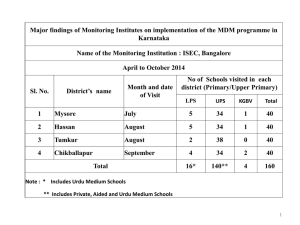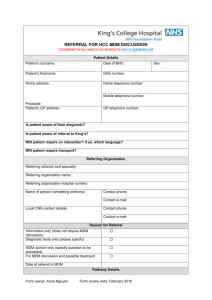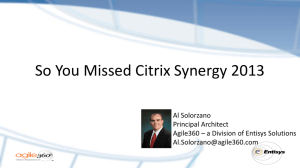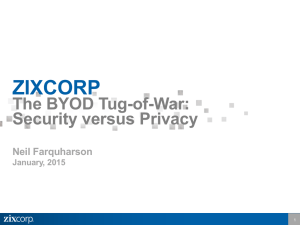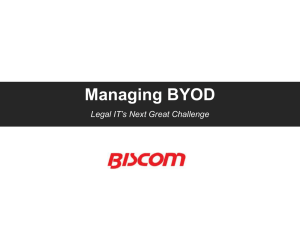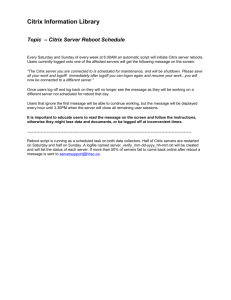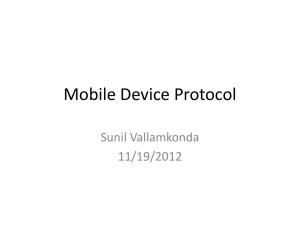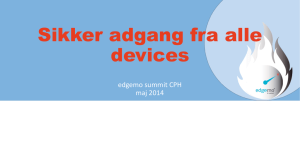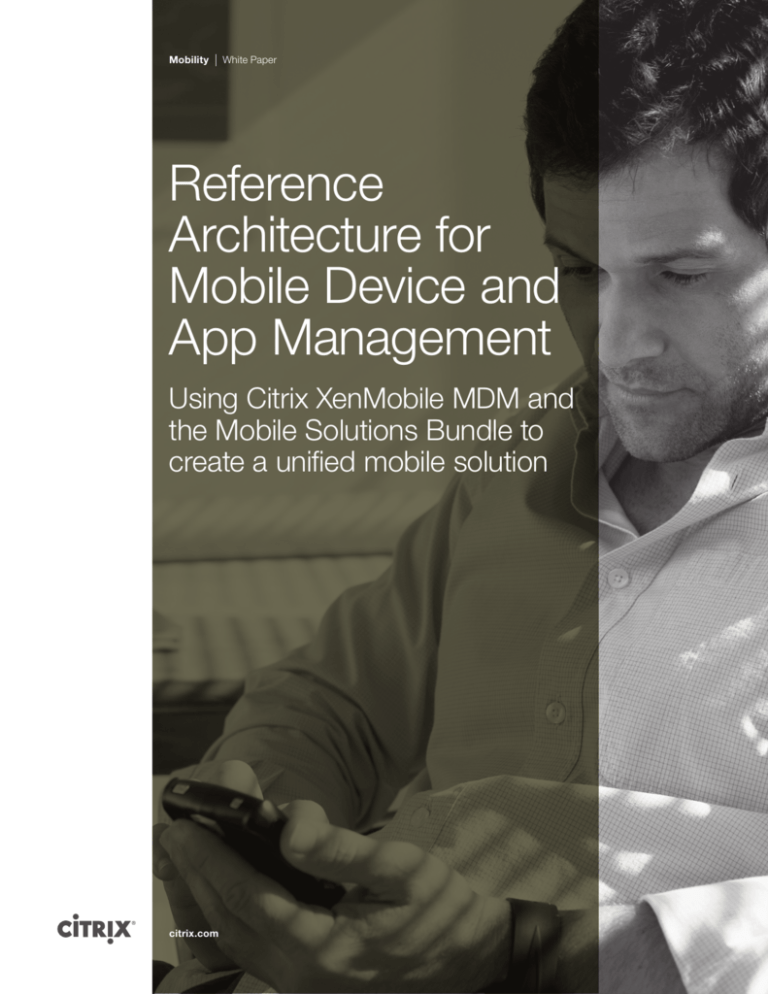
Mobility
White Paper
Reference
Architecture for
Mobile Device and
App Management
Using Citrix XenMobile MDM and
the Mobile Solutions Bundle to
create a unified mobile solution
citrix.com
Mobility
White Paper
2
The Citrix Reference Architecture for Mobile Device
and App Management guides architects in designing
the next generation of mobile device and application
management services. These services allow IT
organizations to gain control over the proliferation
of mobile devices in the enterprise. The Mobile
Solutions Bundle provides a solution that securely
delivers mobile, web, Windows apps, and data to
all devices in the enterprise. The Mobile Solutions
Bundle is the first step in making mobility a strategic
advantage rather than a security liability. This
document is for IT architects looking to implement
and manage their mobility infrastructure. Each of
these validated architectures has been certified by
Citrix to perform and scale to the most demanding
enterprise requirements.
Mobile Solutions Bundle
The Mobile Solutions Bundle combines XenMobile™ MDM, security and
management of mobile end-points with CloudGateway™, a self-service enterprise
app store for business apps, and data to provide a complete mobile solution. Each
of these components includes infrastructure components that will be described in
detail in the following sections.
• XenMobile MDM
• CloudGateway
– XenMobile Device Manager
– AppController
– XenMobile SMG
– Access Gateway
– XenMobile SharePoint DLP
– StoreFront (Windows®
Desktops and Apps)
citrix.com
Mobility
White Paper
XenMobile Device Manager (MDM)
XenMobile MDM offers advanced mobile device management capabilities
like provisioning, automated compliance, and features that make mobile apps
“business-ready”. With a “one-click” dashboard, simple administrative console,
and real-time integration with Microsoft Active Directory XenMobile MDM simplifies
device administration across the enterprise.
XenMobile MDM provides the ability to manage the device lifecycle across every
major platform, including iPhone, iPad, Android, BlackBerry, Symbian, and
Microsoft Windows 8. It offers out-of-the-box support for BYOD programs or
corporate mobile initiatives.
XenMobile SMG
XenMobile Secure Mobile Gateway (SMG) provides the ability to protect mobile
email with MDM policies. It lets mobile users view encrypted attachments in
a secure viewer and keeps sensitive corporate data from leaking outside of
enterprise control on iOS and Android devices.
XenMobile SharePoint DLP
XenMobile SharePoint DLP (Data Leak Prevention) provides SharePoint access
to mobile devices via MDM policies. This feature gives IT administrators control
over the devices that have access to SharePoint data while the native mobile app,
Citrix® Mobile Connect, provides the interface and security to view the documents.
citrix.com
3
Mobility
White Paper
CloudGateway
Citrix CloudGateway is an enterprise mobility management solution that securely
delivers mobile, web, Software as a Service (SaaS), Windows apps, and data to
any device. It empowers employees with a self-service enterprise app store that
provides access to business apps and data, leveraging the consistent, rich user
experience of Citrix Receiver™.
AppController
AppController provides access to web, SaaS, mobile apps, and ShareFile®.
This component allows IT to protect enterprise apps and data with policy-based
controls, such as restriction of application access to authorized users, automatic
account de-provisioning for terminated employees and remote wipe for data and
apps stored on lost devices.
Access Gateway
NetScaler Access Gateway™ provides secure remote access from outside the
corporate network while maintaining the highest level of protection for sensitive
corporate data.
StoreFront
StoreFront, the next-generation of Web Interface, provides a set of services used
by Receiver to enable access to AppController and XenDesktop®.
ShareFile
Citrix ShareFile is a cloud based follow-me-data solution. ShareFile enables users
to securely store, sync and share data, both within and outside the organization.
Using ShareFile with CloudGateway provides IT with enterprise directory
integration capabilities for easy, enterprise-wide provisioning and deployment of
user accounts.
Reference Environments
This document will guide IT administrators through proven architectures based
on the enterprises mobile device and application management requirements. The
following environments have been validated as reference architectures.
• XenMobile MDM
• XenMobile MDM – Secure Proxy
• Mobile Solutions Bundle
• Mobile Solutions Bundle – XenDesktop (XD) integration
• Mobile Solutions Bundle – Multi-Store
• Mobile Solutions Bundle – High Availability
• Mobile Solutions Bundle – NetScaler® as proxy
citrix.com
4
Mobility
White Paper
5
Determining the correct architecture will be based on the device or app
management requirements of the enterprise. The components of the bundle are
modular and build upon each other. The following table displays architectures
based on the mobile technologies. Before making a decision it is important to
determine the following:
• What level of management is required, App vs. Device or both?
• What types of apps need to be managed and deployed?
• What data strategy is required, SharePoint or ShareFile?
XenMobile
MDM
Mobile
Solutions
Bundle
Mobile
Solutions
Bundle
XD Integration
Device Security
Control
X
X
X
Device Provisioning
X
X
X
Native App Delivery
X
X
X
SharePoint
Integration
X
X
X
Web/SaaS App
Delivery
X
X
Mobile MDX Apps
X
X
ShareFile Integration
X
X
Mobile App Policies
X
X
Mobile App Mgmt.
X
X
Win Apps/Desktops
citrix.com
X
Mobility
White Paper
XenMobile MDM
Figure 1 – XenMobile MDM Reference Architecture
1. XenMobile Device Manager (MDM) is the central server for MDM that
combines policies, devices, and users to create deployments to manage the
corporate mobile strategy.
• Devices connect to MDM over ports 80, 443, and 8443 (only during device
enrollment for iOS).
• MDM runs on a Windows Server 2008 R2. It is recommended to follow the
Microsoft security best practices for Windows Servers in the DMZ.
• The MDM Server requires connections to backend infrastructure components
like, Active Directory, DNS, SMTP, SQL Server, and a certificate authority.
• MDM also requires a PKI service like Microsoft Certificate Authority or it can use
its own PKI service hosted on the MDM Server that gets installed with Device
Manager. Device Manager will use this service to push out client certificates
to devices for client certification authentication to MDM. Client certificates are
deployed automatically during device enrollment.
• It is recommended to use SQL Server, Express, Standard, or Enterprise for a
production environment. Reference the following link for supported Windows
and SQL versions.
citrix.com
6
Mobility
White Paper
2. The SharePoint connector is an optional component of XenMobile MDM
that provides access to SharePoint sites. This requires external access to
your SharePoint server by either placing the SharePoint server in the DMZ
or utilizing a load balancer in the DMZ with access to the SharePoint server.
This functionality can be configured in a MDM policy allowing the Citrix Mobile
Connect app to host the SharePoint data in a secure viewer on the mobile
device.
3. X
enMobile Secure Mobile Gateway (SMG) provides protected mobile email
through MDM policies. This can be installed on an Exchange Client Access
Server (CAS) or in the DMZ on a Microsoft Forefront or Threat Management
Gateway (TMG) server. Basic operation requires access to Exchange, MDM,
and mobile devices over HTTPS (443). SMG will query the MDM Server to check
policies for user and device access.
4. The Apple Push Notification Service (APNS) is used by MDM to push
notifications to iOS devices for configuration and policy updates. This is service
provided by Apple and is only required for iOS devices. Non-iOS devices have
their own push implementation.
Note: A special APNS certificate that is signed by Citrix and issued by Apple is
required before installing MDM. Please see installation instructions.
MDM Firewall Ports
The following ports need to be open to allow MDM to communicate with internal
and external resources.
Figure 2 – XenMobile MDM Communication Paths
citrix.com
7
Mobility
White Paper
8
MDM Server Specifications
All components of the MDM architecture can be installed on physical or virtual
machines. The following table describes the resource requirements to support
5000 devices for each of the components in the MDM architecture.
Virtual Machine
vCPU
Memory (GB)
Disk Space (GB)
XM Device Manager
2–4
4
24
Secure Mobile Gateway
2
2
24
XM SQL Server
2
6
24
Enterprises requiring scalability greater than 5,000 devices will need to adjust
server specifications to match the parameters in the table below.
Devices
XenMobile MDM Server
SQL Server
5,000
2 vCPU, 4 GB RAM
2 vCPU, 6 GB RAM
10,000
4 vCPU, 8 GB RAM
4 vCPU, 16 GB RAM
20,000
8 vCPU, 16 GB RAM
16 vCPU, 24 GB RAM
40,000
16 vCPU, 32 GB RAM
32 vCPU, 64 GB RAM
The MDM and database servers can be clustered for high availability, please
reference the High Availability section for more details on clustering the MDM
components. Database backup and recovery should be performed according to
the organization’s data center policy.
Tomcat TCP connections also need to be taken into consideration:
Devices
Port 80
PortMax
Threads
Port 443
Port 8443
Up to 10,000
400
30
20
12
Over 10,000
750
50
50
20
If the TCP connections are getting close to 750, then consider clustering the
MDM Server.
XenMobile MDM with NetScaler option
An alternative and more secure deployment for MDM is to use a hardware load
balancer like NetScaler in front of all the MDM components. In the architecture,
the NetScaler is load balancing all HTTP and HTTPS traffic to MDM, SMG, and
SharePoint.
citrix.com
Mobility
White Paper
Figure 3 – XenMobile MDM with NetScaler
There are several reasons to do this:
• Limit exposure to Windows Servers in the DMZ
• Easily scale out by adding more servers behind NetScaler in the future
• Additional NetScaler features can be enabled to further increase security
(e.g., application firewalls)
Configuration Tip: On the NetScaler device ensure SSL persistence is
enabled and set to SSLSESSION for the HTTPS load balancing virtual servers
(443 and 8443).
Mobile Solutions Bundle
CloudGateway, a component of the Mobile Solutions Bundle, includes Access
Gateway, AppController, and optionally, StoreFront (for XenDesktop and XenApp®
integration). The following components are highlighted in this architecture:
• AppController
• Access Gateway
In this environment, MDM and CloudGateway are installed side-by-side,
complementing each other. MDM provides the device management and
control with policies while CloudGateway provides MDX capabilities and secure
remote access to enterprise resources. The following diagram highlights the
CloudGateway infrastructure components.
citrix.com
9
Mobility
White Paper
Figure 4 – Mobile Solutions Bundle Reference Architecture
1. A
ccess Gateway – NetScaler Access Gateway is used for remote access and
can be installed in the form of a NetScaler hardware appliance (MPX or SDX)
or a VPX (virtual appliance that runs on XenServer®, VMware, or Hyper-V). This
infrastructure component resides in the DMZ and is the central access point
into the enterprise network. For extra security, two-factor authentication using
RADIUS as a secondary authentication method is supported for services such
as like RSA SecurID or Symantec VIP products.
2. AppController – AppController is a Linux-based hardened VPX appliance that
can be deployed on XenServer or VMware. In this configuration, remote access
is available using Access Gateway, but internal users can access AppController
directly with the Receiver or Receiver for Web. AppController includes a version
of Receiver for Web on the same server to allow mobile and desktop receivers
to access apps without the addition of a StoreFront server. AppController
requires connections to LDAP, DNS, NTP, and SMTP servers. SMTP is required
for workflow approval through email notification.
AppController integrates with ShareFile (ShareFile account with SSO enabled is
required) by provisioning Active Directory users to the ShareFile cloud service,
providing Single Sign-on (SSO) to the data service using SAML authentication.
citrix.com
10
Mobility
White Paper
11
3. C
itrix Receiver – Citrix Receiver is client software that lets you access your
data, applications, and desktops from any device including smartphones,
tablets and PCs. Receiver can be downloaded from the device’s app store or
pushed to the device from XenMobile MDM.
CloudGateway Firewall Ports
In addition to the XenMobile MDM firewall ports in the previous environment,
the following ports need to be opened for the CloudGateway infrastructure
components. Ports 1494 and 2598 will only need to be opened if XenDesktop
or XenApp is integrated (shown in next environment).
Figure 5 – CloudGateway Firewall Ports
CloudGateway Server Specifications
All components of CloudGateway can be configured and hosted as virtual
machines. The AppController virtual machine (VM) is a virtual appliance that runs
on XenServer and VMware ESXi. Access Gateway VPX is a virtual appliance that
delivers the same features and functionality as the MPX physical appliance. Access
Gateway VPX is a virtual workload that is deployed on its own hardware. The
following table details the minimum resource requirements.
vCPU
Memory (MB)
Disk Space (GB)
Access Gateway VPX
2
4096
20
App Controller
2
4096
50
citrix.com
Mobility
White Paper
CloudGateway Enterprise Scalability
CloudGateway can support enterprises with thousands of users by selecting
the appropriate NetScaler Access Gateway hardware appliance. As the number
of users authenticating, using mail and web resources and app activity through
MicroVPN increase (Figure 6) the power of the NetScaler Access Gateway
infrastructure component will need to be increased. Please refer to the figure below
to select the appropriate configuration for your environment. These results are
based on an AES encryption algorithm with a 1024bit key size. Scalability results
will differ based on encryption algorithm and key sizes.
Sample user profile used for results below:
• Single connection per user
• Using only @WorkMail™ app
• Traffic usage is approximately 2.5 MB/min per user
CloudGateway User Scalability/NetScaler Appliance
Figure 6 – CloudGateway User Scalability (@WorkMail)
For more information on the NetScaler hardware appliances used in these tests
please refer to the following knowledgebase article.
citrix.com
12
Mobility
White Paper
CloudGateway – XenDesktop Integration
Figure 7 – CloudGateway - XenDesktop integration
1. A
ccess Gateway – Access Gateway provides access to XenDesktop/XenApp
HDX sessions, access to web/SaaS and mobile apps are delivered from the
AppController. The additional configuration needed for this setup of Access
Gateway is providing the Secure Ticket Authority (STA) URLs for XenDesktop/
XenApp to the Access Gateway. This will allow pass-through authentication to
Windows desktops and apps. TCP ports 1494 and 2598 need to be opened for
ICA/CGP traffic between AG and XenDesktop/XenApp.
2. S
toreFront – For access to Windows desktops and apps, StoreFront needs
to be placed in front of the AppController and XenDesktop components.
StoreFront provides resource aggregation. It will enumerate apps from
XenDesktop, XenApp, and AppController to show the user one consolidated
list of resources: Windows apps, desktops, mobile apps, web/SaaS apps,
and data. In this configuration, Storefront needs to know how to pass devicespecific information to AppController like device enrollment information and
key management. These services need to be configured in the web.config
file for proper communication between all three servers. Please follow these
instructions for proper configuration.
3. X
enDesktop – Link the XenDesktop broker or XenApp XML service to
complete the integration with CloudGateway.
citrix.com
13
Mobility
White Paper
CloudGateway – Multi-Store Option
An alternative deployment option exists for organizations that have not yet
consolidated Windows desktops and apps using StoreFront. In this scenario,
Access Gateway is upgraded to version 10 and a separate Access Gateway virtual
server is created to support the Mobile Solutions Bundle. If that is not possible
yet, another configuration is to setup a separate Access Gateway 10 server for
AppController and leave the older AG setup untouched. Either configuration
requires Citrix Receiver to have two stores configured, one for XenDesktop/
XenApp using PN Agent Server and one for AppController. Citrix Receiver has
been enhanced to easily switch between the two stores without having to reauthenticate each time. You will only have to authenticate once for each store.
Figure 8 – CloudGateway – Multi Store Option
1. A
ccess Gateway has to be upgraded first to v10.0.71.6014e or later.
Creating a second AG virtual server will require a separate public URL,
public IP, and certificate.
2. W
eb Interface/PN Agent Server – There are no changes required for
PN Agent Server in this environment. Web Interface Server v5.4 is the
only version supported.
citrix.com
14
Mobility
White Paper
High Availability – XenMobile MDM + CloudGateway
This architecture provides a fully redundant XenMobile MDM and
CloudGateway environment.
Figure 9 – High Availability – XenMobile MDM + CloudGateway
1. A
ccess Gateway HA Mode – In this environment NetScaler devices are
configured in high availability mode. A high availability (HA) deployment of two
NetScaler appliances can provide uninterrupted operation in any transaction.
With one appliance configured as the primary node and the other as the
secondary node, the primary node accepts connections and manages servers
while the secondary node monitors the primary node. If, for any reason, the
primary node is unable to accept connections, the secondary node takes over.
For more information, please follow this link.
2. S
toreFront HA Mode – StoreFront HA mode is similar to the MDM server
setup. It requires a separate SQL server (SQL server should have its own
clustered environment) and a hardware load balancer like NetScaler. Ports
80 and 443 will need to be configured on the load balancer with SSL session
persistence turned on for SSL connections. It is recommended to have multiple
connection broker URLs and STA URLs for XenDesktop/XenApp connections.
For more information, please follow this link.
3. A
ppController – Two AppController VMs can be deployed in a high availability
configuration. The first AppController on which high availability is configured
is called the primary, and the other instance is called the secondary. In
this deployment, the primary AppController listens for requests, serves
citrix.com
15
Mobility
White Paper
user requests, and synchronizes its data with the data on the secondary
AppController. The two VMs work as an active-passive pair, in which only one
VM is active at a time. If the primary AppController stops responding for any
reason, the secondary AppController takes over, becoming the active VM and
begins to service user requests. As the active VM, the secondary AppController
also synchronizes system and database information by using a client-server
mechanism. A client on the active AppController VM shares the necessary
information to a virtual server on the passive AppController as a series of
requests. The virtual server parses the requests and performs the necessary
action. A virtual IP is required; this will be the FQDN AppController address
used when configuring StoreFront and Access Gateway in a CloudGateway
deployment. For more information, please follow this link.
4. X
enMobile MDM HA Mode – XenMobile MDM can be configured with multiple
servers load-balanced behind a NetScaler appliance or another hardware
load-balancing solution. In this environment, ports 80, 443, and 8443 are loadbalanced. For SSL connections (ports 443 and 8443), make sure to turn on SSL
session persistence in the load balancing rules. MDM requires a shared SQL
server and NTP configured on each server.
Note: This configuration is more secure as the MDM servers are located in the
internal network behind the Access Gateway.
Mobile Solutions Bundle with NetScaler
This environment shows NetScaler being a transparent proxy for all MDM
components as well as enabling Access Gateway for the CloudGateway
components. This is an alternative to having multiple servers in the DMZ.
Figure 10 – Mobile Solutions Bundle with NetScaler
citrix.com
16
Mobility
White Paper
In the NetScaler configuration, Load Balancing is used as a proxy for each
component. In this case, only one server is used for each balancer. Here is a
sample configuration for a component server:
Figure 11 – NetScaler Load Balancing Configuration
Reference Environment Infrastructure
In the XenMobile and CloudGateway reference architectures; there are many
supporting servers and services that are required for operation in an enterprise
environment. The following section details the common infrastructure components
(storage, virtualization environment, servers, networking equipment, etc.) and how
the XenMobile and CloudGateway reference architectures integrate with them.
Network Layout
Figure 12 – Network Layout for Reference Environments
citrix.com
17
Mobility
White Paper
18
Server Hardware
XenServer Hosts
Dell PowerEdge C6100
The Dell C6100 contains 4 physical servers enclosed
in a 2U form factor with each server having the
hardware specifications listed below:
• 2 – Intel Xeon E5620 Processors
• 64GB RAM
• 500GB HDD
• 2 – physical machines configured in HA
(High Availability) mode
• 2 – 1Gb Ethernet Adapters
XenServer Configuration
• 2 – servers configured in a virtualization pool for HA
(High Availability)
• XenServer version 6.1.0-59235p
• Three separate VLANs configured:
– VLAN 30 – Storage VLAN configured for 9000
MTU for fast connectivity to backend NFS storage.
– VLAN 10 – User/Management traffic VLAN
configured for standard 1500 MTU. Please note that
it is best practice for XenServer to further segregate
User and Management traffic by creating additional
VLANs in high traffic implementations.
– VLAN 50 – DMZ VLAN to provide access from
outside the enterprise network.
Storage
NetApp 2240-2
• 7.2TB total configurable storage
• Active/Active Controller configuration
• 4.5TB NFS configured storage volume
• ~250GB used for complete virtualized environment
• 2 – 10Gb Ethernet (10GbE) Adapters
Network
Cisco C3560X
Cisco ASA 5520
Authentication
Active Directory running on Windows Server 2008 R2 was used for all reference
architecture environments. Active Directory, or LDAP, support is different for
each product. Both AppController and XenMobile MDM do not support users
in nested groups. Another limitation for AppController is that it only supports a
single forest environment. Please check each product’s documentation for full
support requirements.
The reference environments also make use of two factor authentication configured
on Access Gateway to provide secure access to the internal corporate resources
using RADIUS authentication from Symantec Validation and ID Protection. Using
two-factor authentication will require an extra port to be opened on the firewall
(typically UDP/1812) from DMZ (AG) to the RADIUS server (internal).
More information on configuring two-factor authentication can be found here.
citrix.com
Mobility
White Paper
19
Certificates
Wildcard and SAN certificates are supported for all Citrix products. In most
deployments, only two wildcard or SAN server certificates are required:
1. External – *.extcompany.com
2. Internal – *.intdomain.net
The following table shows the certificates required and format needed for each
component. A simple utility like OpenSSL can be used to convert certificate
formats. A separate SAML Certificate will be needed depending on the SAML
authentication enabled apps that are published in AppController.
Certificate format
Certificates Required
Location
Access Gateway
PEM
Server*, root CA
External
AppController
PEM or PFX (PKCS#12)
Server, SAML, root CA
Internal
StoreFront
PFX (PKCS#12)
Server, root CA
Internal
XenMobile MDM
PFX (PKCS#12)
APNS, server. MDM will
create its own PKI service
or use Microsoft CA for
client certificates.
External
XenMobile SMG
PFX (PKCS#12)
Server, root CA
External
*It is recommended to make this a public (3rd party) cert so mobile devices won’t
need to download the company’s private root CA first.
DNS
It is recommended to use static IPs for all servers in the environment. As
configured in the reference environment the following records were added
to the DNS server.
Server
DNS Location
Record
XenMobile MDM
Internal and External
Host (A)
Access Gateway “
(AG Vserver IP
address)
Internal and External
Host (A)
AppController
Internal
Host (A)
StoreFront
Internal
Host (A)
XenMobile SMG
Internal and External
Host (A) and Mail (MX)
SharePoint DLP
Internal and External
Host (A)
Configuration Tip: Make sure that the FQDN of every server from every other
server, especially Access Gateway can be resolved and pinged.
citrix.com
Mobility
White Paper
SQL Server
SQL server (Express, Standard, and Enterprise) are supported for all the products
in the Mobile Solutions Bundle. It is important to plan accordingly and size the
SQL server based on number of devices, applications and users that will be using
the environment. The same SQL Server may be used for the different products.
It is recommended to size the SQL server based on the MDM requirements. The
impact of StoreFront on SQL is minimal. Please refer to the individual architectures
for sizing recommendations.
Exchange Server and XenMobile Secure Mobile Gateway
In the reference environment, a Microsoft Exchange 2010 server was used to
provide access to secure mail from XenMobile Secure Mobile Gateway. A full
exchange server 2010 implementation includes 5 roles; there are 3 main roles that
need to be configured:
• The Mailbox Server which is the backend server that hosts mailboxes.
• The Hub Transport server that routes mail and handles mail flow.
• The Client Access Server (CAS) which is an edge server that accepts
connections to Exchange server from a variety of clients.
Although all 3 roles mentioned above are required as per the reference
design, more details on the CAS role are included here as the physical
placement of this role on a server in the topology, and the integration with
XenMobile SMG is important.
XenMobile SMG is installed on the CAS and works to manage policy based device
access to email by intercepting ActiveSync traffic using the built-in ISAPI filters
provided by the CAS server. The CAS role is a middle-tier server that accepts
connections to Exchange server from a variety of clients. This server hosts the
protocols used by all clients when checking messages. On the local network,
Outlook MAPI clients are connected directly to the Client Access server to check
mail. Remote users can check their mail over the Internet by using Outlook
Anywhere, Outlook Web App, Exchange ActiveSync, POP3, or IMAP4. While the
CAS role placement is usually dictated by the placement of the Exchange Server
Mailbox server, it is recommended as per the reference architecture that the
CAS role be installed on a stand-alone server that is separate from the Exchange
mailbox server and it resides in the DMZ. Having the CAS server placed in the
DMZ adds an additional layer of security to the implementation by avoiding
the need to place the mailbox server in the DMZ. Instead the CAS server can
communicate with the Exchange server residing on the internal network over
secure communications.
citrix.com
20
Mobility
White Paper
Conclusion
The Citrix Mobile Solutions Bundle is an enterprise mobility management solution
that enables complete and secure mobile device, app and data freedom.
Employees gain quick, single-click access to all their mobile, web, datacenter
and Windows apps from a unified app store, including beautiful productivity apps
that seamlessly integrate to offer a great user experience. The solution provides
identity-based provisioning and control for all apps, data and devices, policy-based
controls, such as restriction of application access to authorized users, automatic
account de-provisioning for terminated employees and selective wipe of apps and
data stored on lost, stolen or out-of-compliance devices. With the Mobile Solutions
Bundle, IT can meet users’ desire for device choice while preventing data leakage
and protecting the internal network from mobile threats.
Figure 13 – Citrix Mobile Solutions Bundle Reference Architecture
citrix.com
21
Mobility
White Paper
Appendix A – Reference Documents
Storefront 1.2
http://support.citrix.com/proddocs/topic/dws-storefront-12/dws-version-wrapper.html
Netscaler 10.0
http://support.citrix.com/proddocs/topic/netscaler/ns-gen-netscaler10-wrapper-con.
html
Access Gateway:
http://support.citrix.com/proddocs/topic/access-gateway/ag-edocs-landing.html
AppController 2.5
http://support.citrix.com/proddocs/topic/appcontroller-25/clg-appc-landing-page-dcon.html
XenMobile Device Manager
http://kb1.zenprise.com/Zenprise_Device_Manager
Secure Mobile Gateway (AKA Active-Synch Controller)
http://kb1.zenprise.com/Zenprise_Device_Manager/Zenprise_Device_Manager/
Secure_Mobile_Gateway
Installation guide – Microsoft Client Access Server
http://technet.microsoft.com/en-us/library/ff622319(v=exchg.141).aspx
Microsoft Client Access Reference for Exchange 2010
http://technet.microsoft.com/en-us/library/ff622319(v=exchg.141).aspx
Microsoft Exchange 2010 Installation Guide Download
(Includes instructions for all required roles)
http://www.microsoft.com/en-us/download/details.aspx?id=17206
citrix.com
22
Mobility
White Paper
23
Appendix B - Firewall port requirements
XenMobile MDM
TCP
Port
Description
Source
Destination
25
By default, the MDM SMTP configuration of the
Notification Service uses port 25. However, if your
corporate SMTP server uses a different port, make
sure that your corporate firewall does not block
that port.
XenMobile MDM
Corporate SMTP
Server
80
Over-the-Air (OTA) Enrollment and Agent Setup
(Android and Windows Mobile)
Internet
XenMobile Device
Manager Server
Over-the-Air (OTA) Enrollment and Agent Setup
(Android and Windows Mobile), MDM Web Console,
MDM Remote Support Client
Corporate LAN and
Wi-Fi
MDM Server Enterprise App Store connection to
Apple iTunes App Store (ax.itunes.apple.com). Used
for publishing recommended iTunes App Store apps
from the available iOS applications within the Web
Console and iOS Mobile Connect App
XenMobile MDM
80 or
443
XenMobile Device Manager Nexmo SMS Notification
Relay outbound connection
XenMobile MDM
Nexmo SMS Relay
server
389 or
636
LDAP/LDAPS connection from MDM Server to
Directory Service Host (Active Directory Global
Catalog server or equivalent LDAP directory service
host)
XenMobile MDM
LDAP / Active
Directory Services
443
SSL OTA Enrollment/Agent Setup (Android and
Windows Mobile), All Device-related traffic and data
connections (iOS, Android and Windows Mobile)
Internet
XenMobile MDM
SSL OTA Enrollment/Agent Setup (Android and
Windows Mobile), All Device-related traffic and data
connections (iOS, Android and Windows Mobile),
MDM Web Console
Corporate LAN and
Wi-Fi
1433
Remote database server connection to separate SQL
Server (Optional)
XenMobile MDM
SQL Server
2195
Apple APNS (Push Notification Service) outbound
connection to gateway.push.apple.com, used for
iOS device notifications and device policy push
XenMobile MDM
2196
Apple APNS (Push Notification Service) outbound
connection to feedback.push.apple.com, used for
iOS device notifications and device policy push
Internet (Apple
APNS Service
Hosts on public IP
network17.0.0.0/8)
5223
Apple APNS (Push Notification Service) outbound
connection from iOS devices connected via Wi-Fi
network to *.push.apple.com
iOS device on Wi-Fi
network service
8443
Over-the-Air (OTA) Enrollment for iOS Devices only
Internet
App Store
(ax.itunes.apple.com)
Corporate LAN and
Wi-Fi
1 Corporate LAN traffic outbound to DMZ and the Internet is assumed to be allowed
citrix.com
Apple iTunes
XenMobile MDM
Mobility
White Paper
24
CloudGateway
TCP
Port
Description
Source
Destination
80
Mobile Application download
Access Gateway
AppController
443
Connections to Storefront Services for Enterprise
edition access to We, Mobile, SaaS and Desktop
Applications
Access Gateway
StoreFront
Connections to AppController for Web, Mobile and
SaaS application delivery
Access Gateway
AppController
Secure Ticket Authority (STA)
Access Gateway
Citrix XD / XA
Servers
389,
636 or
3268
LDAP/LDAPS connection from NetScaler AG to
Directory Service Host (Active Directory Global
Catalog server or equivalent LDAP directory service
host)
Access Gateway
LDAP / Active
Directory
Services
53
DNS
Access Gateway
DNS Server
123
NTP Services
Access Gateway
NTP Server
1494
Citrix ICA Protocol
Access Gateway
Citrix XD / XA
Servers
2598
Citrix ICA/CGP Protocol
Access Gateway
Citrix XD / XA
Servers
When Session Reliability is enabled, TCP port 2598
replaces port 1494
1 Corporate LAN traffic outbound to DMZ and the Internet is assumed to be allowed
Corporate Headquarters
Fort Lauderdale, FL, USA
India Development Center
Bangalore, India
Latin America Headquarters
Coral Gables, FL, USA
Silicon Valley Headquarters
Santa Clara, CA, USA
Online Division Headquarters
Santa Barbara, CA, USA
UK Development Center
Chalfont, United Kingdom
EMEA Headquarters
Schaffhausen, Switzerland
Pacific Headquarters
Hong Kong, China
About Citrix
Citrix (NASDAQ:CTXS) is the cloud computing company that enables mobile workstyles—empowering people to work and collaborate from
anywhere, accessing apps and data on any of the latest devices, as easily as they would in their own office—simply and securely. Citrix cloud
computing solutions help IT and service providers build both private and public clouds—leveraging virtualization and networking technologies
to deliver high-performance, elastic and cost-effective services for mobile workstyles. With market-leading solutions for mobility, desktop
virtualization, cloud networking, cloud platforms, collaboration and data sharing, Citrix helps organizations of all sizes achieve the kind of speed
and agility necessary to succeed in an increasingly mobile and dynamic world. Citrix products are in use at more than 260,000 organizations
and by over 100 million users globally. Annual revenue in 2012 was $2.59 billion. Learn more at www.citrix.com.
©2013 Citrix Systems, Inc. All rights reserved. Citrix®, XenMobile™, Access Gateway™, Citrix Receiver™, ShareFile®, @WorkMail™, XenDesktop®,
XenApp®, XenServer ® and NetScaler ® are trademarks or registered trademarks of Citrix Systems, Inc. and/or one or more of its subsidiaries, and
may be registered in the United States Patent and Trademark Office and in other countries. All other trademarks and registered trademarks are
property of their respective owners.
0313/PDF
citrix.com

